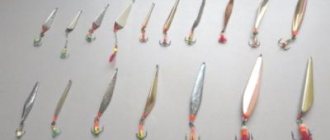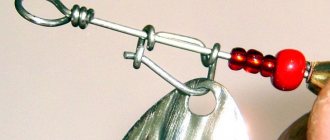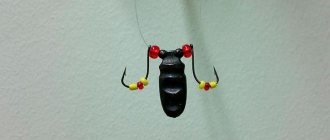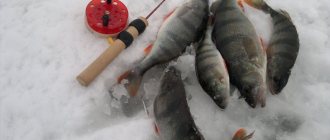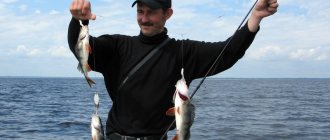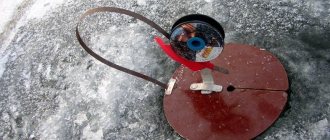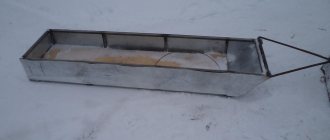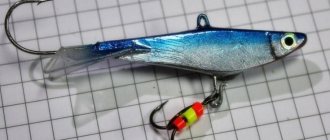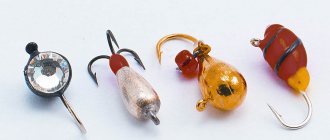Main characteristics of a spinner for perch
Lure for catching perch in winter has a number of characteristics and features, without the knowledge and proper use of which, effective fishing will not work. Types of spinners: oscillating; rotating; acoustic; balance; sheer. These species vary in size into small, medium and large.
They also differ in the type and number of hooks, and in the location of the center of gravity of the load. A successful model of a vertical spinner is the popular winter tackle invented by Matveychikov.
How does a spoon work in the water column?
Both types of Minsk spoons (with a fixed hook fastening and a suspended one) are designed for fishing in the water column. The peculiarity of the process is that during the swing-pause, swing-pause play cycles, the spinner does not reach the very bottom. Those. The spoon should be lowered to the bottom and raised by 3-5 cm, after which the game cycles should begin. It is important to pay attention to the pause in the game with spinners. Those. for the period of time during which the spoon returns to its original position, i.e. vertically. And only after stopping should the next cycle of the game begin.
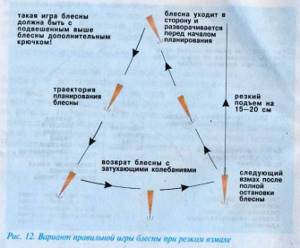
By making a spoon with your own hands and following all the recommendations for the style of fishing with a Minsk spoon, you will get real pleasure from winter fishing.
How to make a Matveychikov spinner with your own hands
After studying the prices in fishing stores, the idea arises of making a Matveychikov bait yourself. If you have the skills to work with soft metal, a soldering iron and simple tools, this is not difficult. Matveychikov’s store-bought winter spinner is taken as the basis.

Possible size range: from 30 mm to 55 mm. This will simplify the manufacturing process - you won’t have to throw away the workpiece if there is an error of a few millimeters. It is worth making several parts at once, indicating different sizes in the drawings.
While fishing in the same place, you can try plates of different sizes and weights, determining which type gives the greatest increase in fish catch. To make each new spinner, you will need a sheet of copper more than 0.5 mm thick.
You can take any other similar material, since there are no restrictions other than the author’s imagination. The only limitations are the excessive rigidity of the metal, which will not allow you to work with it at home without special tools, and the insufficient level of reflection of its surface, which will not allow the perch to see the bait.
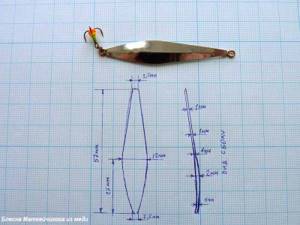
Of course, you can paint or spray the finished bait. However, while painting the surface is simple, metal spraying or electroplating requires special skills.
Before starting work, the copper sheet must be divided into blanks similar in size to the bait being made. The size will be approximately 20 mm by 30-55 mm. Next, grab some fish hooks. Quite often they take the “eight”. But there are no restrictions here either.
It is better to make several options, with different sizes of hooks, tees, and so on. The last thing you need is rosin, solder, soldering acid. You usually don't need much solder.
Materials for making winter spinners
The photograph shows a drawing and view of a winter perch vertical spinner, made by filling a thin brass substrate with solder.
And in the topic we will talk about materials suitable for making homemade perch vertical lures using my methods, the age of which is indicated in the previous article.
These ancient methods of soldering winter lures for catching perch were invented and tested against the backdrop of a shortage of such baits during socialist times.
Currently, to make vertical perch lures for my fishing trips, I use the same methods and materials as before.
If you would like to look at my homemade spinners for catching perch, made from the most scarce materials, what is called “live”, then open the video Shapes of homemade perch spinners.
Or first, read the articles on homemade perch vertical lures used on my fishing trips, which I have never divided into summer and winter, since I fish with them all year round.
There are enough materials around us to make winter lures for perch, pike perch, and pike. Their thickness can be different, but it’s easier to solder a vertical winter bait on a piece of thin-rolled homogeneous metal.
The materials for the manufacture of my winter spinners are mainly thin-rolled alloys of various non-ferrous metals.
Fishermen who are keen on embossing can use scraps of foil or whole sheets sold in specialized stores as materials for making winter lures. As already mentioned in the previous article, the material for making spinners for summer and winter fishing can be broken silver coins.
Only before this the silver should be rolled out, which is impossible to do at home. After such an operation, the thickness of the coin decreases by 10-15 times, but the area of the rolled material increases by about the same amount. Then follows the annealing of the metal, which must be done before making jigs and winter spinners.
The photograph shows the contours of the balancers drawn from the patterns. Here, the material for making horizontal spinners is thin-rolled brass.
Patterns of blank winter lures for catching perch in a plumb line can be cut according to the drawings presented in the archive.
You can choose the material for making foil spinners based on both thickness and alloy composition. If you decipher it, then - by color.
If you take a closer look at the containers for bulk mixtures at home, then the question is “ what to make a spinner out of?” will disappear by itself - even an ordinary metal lid for rolling into jars for storing food can serve as a material from which you can make more than one winter spinner.
Let’s say the material for making the “winter” perch lures shown in the photo were cans.
True, the disadvantage of coated metals is that they cannot be annealed, since thin chemical films simply burn out when heated.
But, given the small thickness of the material on the side walls of the cans, this is not necessary. Winter lures for perch can be made without annealing thin material, giving the backing petals any desired shape.
But it should be borne in mind that most coatings are, on the contrary, very resistant to weak acids.
Therefore, when making winter lures by soldering, even if you use soldering acid for tinning, you should first clean the surface of the workpiece material with sandpaper.
Thanks to this, the process of filling the petal of a winter spinner with solder will take much less time. The anti-corrosion coating on the front side of the homemade vertical bait will remain more durable.
Good materials for making winter lures are thin-walled copper, brass and bronze tubes. First, they are cut along the longitudinal axial line, then straightened with a hammer and annealed.
The contour of a vertical winter bait is drawn on the straightened metal material, which is trimmed with scissors and processed with a file.
Next comes the process of manufacturing the longitudinal profile of the vertical bait blank, that is, the necessary bends are made and the petal is filled with solder.
Blanks of winter spinners made of metal with a thickness of 1.5-2 mm are cut out with a small chisel. Their contour is processed with files, and all bends are knocked out on a metal plate or a dense wooden block with a small hammer.
When making perch, zander and pike winter lures of complex shapes, I use homemade devices and mandrels. This almost always requires preliminary annealing of the metal.
Blank drawing
To make a bait, you need a drawing, which is best done on a sheet of special graph paper. This simplifies the work of subsequent adjustment of the workpiece to the required dimensions.
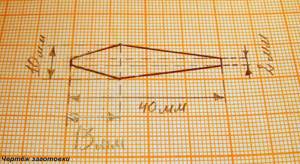
Do-it-yourself winter lure for perch: drawings
What other winter lures for perch can be made?
If you are serious about making spinners, you should not limit yourself to just one model. It will be interesting to see how the fish behave on different baits. Each type requires its own pattern of play, its own sharpness of movement of the fishing rod and frequency of oscillations. To create a bait for catching perch, a drawing will be needed. There are several typical spinners for winter perch fishing:
- The torpedo is designed for catching perch in small bodies of water.
- Coffin is a bait for perch in any reservoir with low current speed. Feature: the line is as thin as possible, excellent vertical play.
- Minskaya is suitable for fishing for perch in any reservoir. Works well for both single and schooling perch.
There is also a crow's foot, the drawings for which are difficult to get. It is well suited for great depths and plays at different current speeds. Since there are no original drawings, each master does this work in his own way. Even the names are different: women's heel, goat's leg. Therefore, there are no generally accepted drawings and models; there are only the most well-known and widespread ones.
Making tool
Measuring tools are an important part, as they are responsible for the accuracy of the initial data. The first work is done from a sample; incorrect measurements can lead to later rejection of the entire workpiece.
If the data on the dimensions of the product are known in advance, when drawing up a drawing and transferring the dimensions to the workpiece, errors may arise that will negate all the work. Therefore, it is better to choose a high-quality metal ruler, calipers and other measuring instruments.
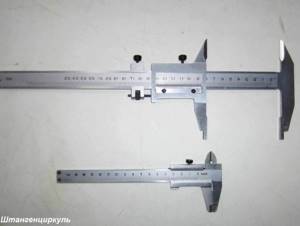
Since the tackle is made of metal, you will need special scissors, a vice, an anvil (or similar), a set of hammers of various sizes, and a mallet. You can't do without a good file and needle file. To heat and solder tin, you will need a soldering iron, a high-temperature torch, and a container in which you can melt and pour the metal. After soldering, you will need a container for cooling.
When performing the final processing, you will need skins, special fabrics for final polishing, GOI paste or an equivalent.
Where to get material for a spinner
Most often, Matveychikov’s homemade winter spinner is made from cupronickel or copper. You can purchase any of these materials both in city markets and online. A good option would be to find like-minded people on a specialized forum and buy the material together. Tin is also sold in stores and markets. Using it, we take, for example, any piece of brass and glue it tightly.
If lead is needed, it can be obtained from an old battery. The only thing is that you must follow safety rules, since the battery contains acid and alkali.
Step by step guide
Step 1 . Determine the size of the required bait (35 or 55 mm). Making Matveychikov's bait even smaller or larger is inappropriate, since it will not play vertically. For the winter spinner flumen by Vladimir Matveychikov, the workpiece will measure 40 mm by 10 mm;
Step 2 . We draw up a drawing of the product. If you have a sample, take measurements from it using a ruler or carefully trace it directly on paper. However, for Matveychikov’s tackle the second method is not suitable, since it is curved.
Step 3. Transfer all dimensions to a copper sheet 0.5 mm thick, and use metal scissors to cut out a blank 40 mm by 10 mm. Afterwards, on the workpiece, mark a straight line in the middle with a pencil. Next, we draw along this line with a sharp object.
Step 4. On each side of the wide edge, measure 13 mm and draw a line between them, also first with a pencil and then with a sharp object. It should look like a cross. At a distance of 5 mm from the center line, on the side opposite to the “bar” of the cross, we make two notches. After drawing all the lines and notches, you should get a copy of the drawing on the drawing. Now you need to cut off the excess.
Step 5 . We bend the sheet along the drawn first line, reaching an angle of 90 degrees. We find the notch that was made at a distance of 5 mm and draw a line through it. After this, we cut lines along two more notches with a sharp object. We take metal scissors and cut two long corners from the crossbar of the cross downward, and two small corners from the crossbar of the cross upward. We cut carefully so that no part of the workpiece remains in our hands. You should get a sketch drawn on the drawing, bent in half.
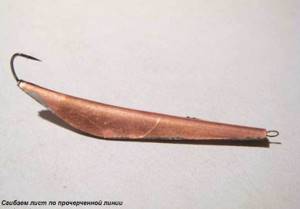
Step 6. Using a file and a needle file, we grind down the corners from the bottom and along the edges of the crossbar, giving them smoothness.
Step 7 . We bend the workpiece to the outside, making the rib from a straight one, curved in the shape of a crescent.
Step 8 . Then we take a hook or tee. We cut off its ear and solder it from below, from the side of the thick part of the part. You need to fill it well around the tee with the coupling material, the same tin, for example.
Step 9. We make a loop for the tackle. We take a strong wire, you can cut the eye of a needle to 10-15 mm. We solder the eyelet from above, that is, from the narrow side of the spinner.
Step 10 . We polish the resulting product with sandpaper, then with a cloth with GOI paste. We use an old toothbrush. Let's add shine. Matveychikov's spinner is ready!
Alternatives to Matveychikov bait
Winter flumen of Vladimir Matveychikov is not a monopolist on perch fishing. There are many varieties. The classic diamond is a spinner that every Soviet person has seen or had in their set. It is made of brass. This winter tackle is designed for catching perch at a depth of up to 5 meters in lakes. Its effectiveness is debatable, but probably every second person has tried fishing with it.

St. Petersburg sleeper is a winter bait made of copper and brass. Indeed, it resembles a sleeper or a Twix stick. Used for catching perch under ice, in running water. Spinner is a tube for winter fishing. A piece of brass pipe with a diameter of 5 mm, where one end is beveled at an angle of 45 degrees, so that it moves unevenly, but with turbulence, unwinding from the flow.
A treble hook can be attached. Well suited for fast currents and for fishing to a depth of one or two centimeters of water, where perch and pike species take it well.
Drawings of working lures for perch
A drawing or template will only be needed to immediately solder a batch of approximately identical WORKING homemade vertical spinners for catching perch on winter or summer fishing trips.
The definition of “workers” is not in vain - the Internet is teeming with offers to buy some mythical, so-called CATCHable lures for perch - homemade and industrially made. And, as I understand it, such a spoon should almost catch us a large perch without our participation.
True, for some reason the unsurpassed masters of such homemade products do not offer drawings of their wonderful winter vertical perch lures for public evaluation.
But, if you turn your head on for a while and think a little, then even a novice fisherman becomes clear: such spinners simply do not exist in nature. The same homemade vertical perch bait cannot work the same under different perch fishing conditions, and no “secret” drawings will help it with this.
You can also get acquainted with the details of making working perch vertical lures according to drawings or according to some of your own estimates and considerations in a rather large topic covering several pages, starting with the article How to make a spinner for fishing.
Next, for your orientation, using the example of a drawing of a vertical perch spoon, I will introduce you to the essence of the topic.
